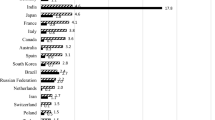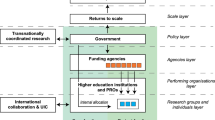Abstract
In this study, we use a unique dataset covering all higher education institutions, public research Institutions and private companies that have applied for funding to the European Framework Programs for Research and Innovation in the period 2007–2017. The first aim of this study is to show the composition of R&D performing actors per country, which to the best of our knowledge has never been done before. The second aim of this study is to compare country profiles in R&D composition, so that we may analyse whether the countries differ in concentration of R&D performing institutions. The third aim of this study is to investigate whether different R&D country profiles are associated with how the R&D systems perform, i.e. whether the profiles are associated with Research and Innovation performance indicators. Our study shows that the concentration of R&D actors at country-level and within the sectors differ across European countries, with the general conclusion being that countries that can be characterized as well-performing on citation and innovation indicators seem to combine (a) high shares of Gross Domestic Expenditure on R&D as percentage of GDP with (b) a highly skewed R&D system, where a small part of the R&D performing actors account for a very high share of the national R&D performance. This indicates a dual R&D system which combines a few large R&D performing institutions with a very large number of small actors.

Similar content being viewed by others
Notes
For example; a public nursing home: should it be treated as an individual unit, or is it part of a municipality? If it is not public, is it a private corporate that has the ownership (PRC) or is it voluntary organizations which runs the nursing home (OTH)?
For Serbia, data on PCT patent applications is not available. We have thus calculated Serbia’s Intellectual assets score based on design and trademark applications only.
Russia and Ukraine are not included in this study.
Greece, Cyprus, Malta and Iceland have not been chosen as reference values and are given the score 1.00 equal to the second-highest performing country.
References
Acosta, M., Coronado, D., Ferrandiz, E. & Leon, M. (2012). Quantity or quality? What do academic R&D funds promote? Paper presented at the DRUID 2012 (June 19–21), Copenhagen.
Agrawal, A. K., Cockburn, I. M., Galasso, A., & Oettl, A. (2014). Why are some regions more innovative than others? The role of small firms in the presence of large labs. Journal of Urban Economics, 81, 149–165.
Aksnes, D. W., Sivertsen, G., van Leeuwen, T. N., & Wendt, K. K. (2017). Measuring the productvity of national R&D systems: Challenges in cross-national comparisons of R&D input and publication output indicators. Science and Public Policy, 44(2), 246–258.
Anic, I.-D. (2017). Facilitating effective science-industry collaborative research: A literature review. Privredna kretanja i ekonomska politika, 26, 7–40.
Ankrah, S., & Al-Tabbaa, O. (2015). University–industry collaboration: A systematic review. Scandinavian Journal of Management, 31(3), 387–408.
Bjerke, L., & Johansson, S. (2015). Patterns of innovation and collaboration in small and large firms. Annals of Regional Science, 55, 221–247.
Boschma, R. A. (2005). Proximity and innovation: A critical assessment. Regional Studies, 39, 61–74.
Braunerhjelm, P., Ding, D. & Thulin, P. (2014). Does labor mobility foster innovation? Evidence from Sweden. In Working paper 30. Swedish Entrepreneurship: Forum.
Braunerhjelm, P., Ding, D., & Thulin, P. (2018). The knowledge spillover theory of intrapreneurship. Small Business Economics, 51, 1–30.
Breznitz, S. M., & Feldman, M. P. (2012). The engaged university. Journal of Technology Transfer, 37(2), 139–157.
Caloghirou, Y., Tsakanikas, A., & Vonortas, N. S. (2001). University–industry cooperation in the context of the European Framework Programmes. The Journal of Technology Transfer, 26(1), 153–161.
Cardamone, P., Pupo, V., & Ricotta, F. (2016). Do firms benefit from university research? Evidence from Italy. Italian Economic Journal, 2(3), 445–471.
Commission, European. (2015). An analysis of the role and impact of Research Performing Organisations’ participation in the Framework Programmes (PP-01264-2104). Brussels: European Commission, Directorate General for Research & Innovation.
Cunningham, J. A., & Link, A. N. (2015). Fostering university–industry R&D collaborations in European Union countries. International Entrepreneurship and Management Journal, 11(4), 849–860.
D’Este, P., Guy, F., & Iammarino, S. (2013). Shaping the formation of university–industry research collaborations: What type of proximity does really matter? Journal of Economic Geography, 13(4), 537–558.
Ebersberger, B., & Herstad, S. J. (2012). The relationship between international innovation collaboration, intramural R&D and SMEs’ innovation performance: A quantile regression approach. Applied Economic Letters, 20(7), 626–630.
Ebersberger, B., & Lööf, H. (2005). Multinational enterprises, spillover, innovation and productivity. International Journal of Management Research, 4, 7–37.
Edquist, C., Zabala-Iturriagagoitia, J. M., Barbero, J., & Zofío, J. L. (2018). On the meaning of innovation performance: Is the synthetic indicator of the Innovation Union Scoreboard flawed? Research Evaluation, 27(3), 196–211.
Ejsing, A., Kaiser, U., Kongsted, H., & Laursen, K. (2013). The role of university scientist mobility for industrial innovation. IZA discussion paper 7470.
Eriksson, T., & Moritz Kuhn, J. (2006). Firm spin-offs in Denmark 1981–2000—Patterns of entry and exit. International Journal of Industrial Organization, 24(5), 1021–1040.
Etzkowitz, H., & Leydesdorff, L. (2000). The dynamics of innovation: From national systems and ‘Mode 2’ to a Triple Helix of university–industry–government relations. Research Policy, 29(2), 109–123.
European Commission. (2018). European innovation scoreboard.
Eurostat. (2017). Eurostat news release 183/2017—1 December 2017.
Falk, M. (2006). What drives business Research and Development (R&D) intensity across Organisation for Economic Co-operation and Development (OECD) countries? Applied Economics, 38(5), 533–547.
Fantino, D., Mori, A., & Scalise, D. (2015). Collaboration between firms and universities in Italy: The role of a firm’s proximity to top-rated departments. Italian Economic Journal, 1, 219–251.
Fontana, R., Geuna, A., & Matt, M. (2006). Factors affecting university–industry R&D projects: The importance of searching, screening and signalling. Research Policy, 35(2), 309–323.
Frenken, K., Heimeriks, G. J., & Hoekman, J. (2017). What drives university research performance? An analysis using the CWTS Leiden Ranking data. Journal of Informetrics, 11, 859–872.
Frenken, K., van Oort, F. G., & Verburg, T. (2007). Related variety, unrelated variety and regional economic growth. Regional Studies, 41(5), 685–697.
Giuliani, E., & Arza, V. (2009). What drives the formation of ‘valuable’ university–industry linkages? Insights from the wine industry. Research Policy, 38(6), 906–921.
Hottenrott, H. & Lawson, C. (2012). Research grants, sources of ideas and the effects on academic research. Discussion paper no. 12-048. Zentrum für Europäische Wirtschaftsforschung GmbH.
Hottenrott, H., & Thorwarth, S. (2011). Industry funding of university research and scientific productivity. Kyklos, 64(4), 534–555.
Jong, S., & Slavova, K. (2014). When publications lead to products: The open science conundrum in new product development. Research Policy, 43(4), 645–654.
Kaiser, U., Kongsted, H., & Rønde, T. (2015). Does the mobility of R&D labor increase innovation? Journal of Economic Behavior & Organization, 110, 91–105.
Keller, W., & Yeaple, S. R. (2009). Multinational enterprises, international trade, and productivity growth: Firm-level evidence from the United States. Review of Economics and Statistics, 91(4), 821–831.
Laursen, K., Reichstein, T., & Salter, A. (2011). Exploring the effect of geographical proximity and university quality on university–industry collaboration in the United Kingdom. Regional Studies, 45(4), 507–523.
Lepori, B., Veglio, V., Heller-Schuh, B., Scherngell, T., & Barber, M. (2015). Participations to European Framework Programs of higher education institutions and their association with organizational characteristics. Scientometrics, 105(3), 2149–2178.
Leydesdorff, L., & Wagner, C. (2009). Macro-level indicators of the relations between research funding and research output. Journal of Informetrics, 3, 353–362.
Lopez, S. F., Astray, B. P., Pazos, D. R., & Calvo, N. (2015). Are firms interested in collaborating with universities? An open-innovation perspective in countries of the South West European Space. Service Business, 9(4), 637–662.
Maietta, O. W. (2015). Determinants of university-firm R&D collaboration and its impact on innovation: A perspective from a low-tech industry. Research Policy, 44(7), 1341–1359.
McKelvey, M., Zaring, O., & Ljungberg, D. (2015). Creating innovative opportunities through research collaboration: An evolutionary framework and empirical illustration in engineering. Technovation, 39–40, 26–36.
Melin, G. (2000). Pragmatism and self-organization: Research collaboration on the individual level. Research Policy, 29, 31–40.
Moed, H. F., de Moya-Anegon, F., Lopez-Illescas, C., & Visser, M. (2011). Is concentration of university research associated with better research performance? Journal of Informetrics, 5, 649–658.
Mowery, D. C., & Sampat, B. N. (2006). Universities in national innovation systems, chapter 8. In J. Fagerberg, D. C. Mowery, & R. Nelson (Eds.), The Oxford handbook of innovation. Oxford: Oxford University Press.
Nooteboom, B., van Haverbeke, W., Duysters, G., Gisling, V., & van den Oord, A. (2007). Optimal cognitive distance and absorptive capacity. Research Policy, 36, 1016–1034.
Parish, A. J., Boyack, K. W., & Ioannidis, J. P. A. (2018). Dynamics of co-authorship and productivity across different fields of scientific research. PLoS ONE, 13(1), e0189742.
Piro, F. N., Scordato, L. & Aksnes, D. W. (2016). Choosing the right partners. Norwegian participation in European framework programmes. NIFU Report 2016: 41. Oslo, NIFU.
Piro, F.N., Tømte, C., Rørstad, K. & Thune, T. (2013). Langsiktig kunnskapsutvikling på næringslivets premisser? Evaluering av Nærings-ph.d.-ordningen. NIFU-rapport 2/2013. Oslo, NIFU.
Simeth, M., & Raffo, J. D. (2013). What makes companies pursue an open science strategy? Research Policy, 42(9), 1531–1543.
Solberg, E., Larsen, K., Wiig, O., Aagaard, K. & Sivertsen, G. (2012). Markets for applied research. A comparative analysis of R&D-systems in five countries. NIFU Report 46/2012. Oslo, NIFU.
Steinmo, M., & Rasmussen, E. (2016). How firms collaborate with public research organizations: The evolution of proximity dimensions in successful innovation projects. Journal of Business Research, 69(3), 1250–1259.
Tijssen, R., Lamers, W., & Yegros, A. (2017). UK universities interacting with industry: Patterns of research collaboration and inter-sectoral mobility of academic researchers. Working paper no. 14. March 2017. London, Centre for Global Higher Education working paper series.
Wagner, C. S. (2005). Six case studies of international collaboration in science. Scientometrics, 62(1), 3–26.
Waltman, L., Calero-Medina, C., Kosten, J., Noyons, E., Tijssen, R. J. W., Van Eck, N. J., et al. (2012). The Leiden Ranking 2011/2012: Data collection, indicators, and interpretation. Journal of the American Society for Information Science and Technology, 63(12), 2419–2432.
Yang, H., Zheng, Y., & Zhao, X. (2013). Exploration or exploitation? Small firms’ alliance strategies with large firms. Strategic Management Journal, 35(1), 146–157.
Funding
This study was funded by R-QUEST, Research Council of Norway Grant Number 256223.
Author information
Authors and Affiliations
Corresponding author
Ethics declarations
Conflict of interest
The authors declare that they have no conflict of interest.
Rights and permissions
About this article
Cite this article
Piro, F.N. The R&D composition of European countries: concentrated versus dispersed profiles. Scientometrics 119, 1095–1119 (2019). https://doi.org/10.1007/s11192-019-03062-7
Received:
Published:
Issue Date:
DOI: https://doi.org/10.1007/s11192-019-03062-7




